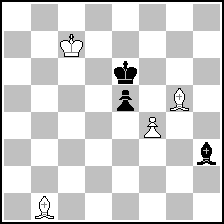|
|
| (1) Posted by Bob Baker [Monday, Apr 15, 2019 05:38] |
Questions from a novice problemist about a type of position
How common is it, in composing studies and directmate problems that end with a win, to have a position arise after the initial position where the winning player has only one legal move? Is there a name for that kind of position? Do you know of any compositions that feature that kind of position, either intentionally or accidentally? Thanks.
Maybe I could have asked that more simply. Does the winning line past the key move ever include a move that is the winner's only legal move?
|
|
| (2) Posted by Steffen Slumstrup Nielsen [Monday, Apr 15, 2019 07:47] |
It must be quite common. For instance this study of mine with, I think, 7 occurrences.
http://view.chessbase.com/cbreader/2019/4/15/Game462195953.html
|
|
| (3) Posted by Geir Sune Tallaksen Østmoe [Monday, Apr 15, 2019 11:05]; edited by Geir Sune Tallaksen Østmoe [19-04-15] |
Yes, that must be common. In a study, I don’t think of an «only move» as any more problematic as an «obvious» move.
|
|
| (4) Posted by Bob Baker [Monday, Apr 15, 2019 13:00] |
Thank you Steffen. Your study was very useful to me.
As an aside, I was curious about something I saw in the study. After 18. Ka4, why did you choose Nb6+ (m38) for your main line instead of Ra2+ (m43), which seems to let Black push the white king around at least four moves longer than in your main line?
|
|
| (5) Posted by Steffen Slumstrup Nielsen [Monday, Apr 15, 2019 21:29] |
I chose this main line to emphasize the try 3. Ne2+ (which is what this study is about, without this try the study would just shows a long forced sequence).
The length to mate is not really relevant. According to convention, a composer of studies may even chose a black move leading to a quick mating finish if the alternative moves lead to "easy wins".
|
|
| (6) Posted by Geir Sune Tallaksen Østmoe [Monday, Apr 15, 2019 22:24] |
One example of what Steffen mentions is my study from The Problemist 2013 (position after 6 moves):
 (= 4+3 ) (= 4+3 )
7.f5+! Bxf5 8.Ba2#
Of course, the tablebases scream at the sight of 7...Bxf5, and I would consider it a weakness of the study if it was hard to demonstrate the win after 7...Kd5 or 7...Kf7. But it is easy to demonstrate White's pawn will queen in both cases, so I don't consider those lines weaknesses.
Studies are relatable to OTB games in this sense. In neither studies nor OTB games is the distance to mate really relevant. I think back to a game I played against Magnus Carlsen many years ago, where he mated my king in the middle of the board. I later saw someone commenting that I blundered because I had a better defense. The "better" defense turned out to be a position where Carlsen would have a queen and two pawns for a rook and a knight, in addition to an attack which would soon be decisive. Even though Carlsen was "only" a 2500 GM at the time, he would have beaten me 100 of 100 times from that position. The defense was simply not a relevant option. In contrast, the defense I chose gave him a mating attack, but it would still have been possible for him to go wrong. My choice was not a blunder, it was the best practical try, even though the engines dislike it because the distance to mate got much shorter.
|
|
| (7) Posted by Bob Baker [Monday, Apr 15, 2019 23:28] |
Thanks for the enlightening replies. They tell me there's a lot to learn to become a composer of good studies. I don't have the experience to know what gets the attention of the judges of chess compositions. I know I was impressed by Geir's drawn AUMS position with 32 consecutive ! half-moves. It makes me eager to see what he will do with the no-capture version of that task.
|
|
No more posts |
MatPlus.Net  Forum Forum  General General  Questions from a novice problemist about a type of position Questions from a novice problemist about a type of position |
 ISC 2025
ISC 2025 Forum
Forum  General
General  Questions from a novice problemist about a type of position
Questions from a novice problemist about a type of position 


